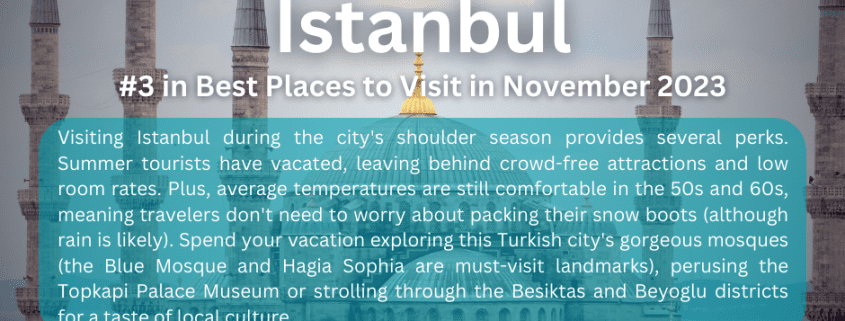Istanbul #3 in Best Places to Visit in November 2023
Why Go To Istanbul
Bridging East and West – Europe and Asia – Istanbul possesses a richly complicated heritage. Once the capital of the Ottoman and Byzantine empires, this city’s prestigious history has left us with many monuments to cherish. Plus, it integrates its past and present to create a unique mix of architecture; a glass skyscraper next to a Byzantine church or a colorful bazaar in the shadow of a shopping mall. The natural landscape is also impressive. The Bosphorus, a narrow strait, cuts the city in two and connects the Sea of Marmara in the south to the Black Sea in the north. From the blue waters, visitors will see a skyline of domes, steeples, and modern towers.
Although Istanbul looks serene from afar, the internal atmosphere is wonderfully chaotic. Discover the bustling streets and busy bazaar stalls that have characterized the city for hundreds of years. Drivers will jockey for position; shopkeepers will barter in an avalanche of chatter; and you’ll be struggling to digest all of the sights, sounds, and smells. Speaking of smells – during your exploration, smell and taste the distinctly Turkish treats off the streets, including döner, Istanbul’s version of fast food. And when the sun goes down, you’ll see that Istanbul sheds some of its conservative facade to reveal a thriving nightlife. At the intersection of civilizations and continents for centuries, Istanbul surprises visitors with its fast pace, its ancient history, and its present culture.
Best Months to Visit
The best times to visit Istanbul are from March to May and between September and November. That’s when crowds at the city’s attractions are manageable, room rates are average, and daytime temperatures generally sit in the 60s and 70s. Peak season – from June to August – sees temps soar into the low 60s to low 80s, and accommodation prices increase to match the demand from incoming tourists. December through February, meanwhile, are the cheapest months to visit, but Istanbul’s rainy, snowy and chilly conditions (temps are in the high 30s to high 50s) mean you’ll have to don cold weather attire and lug an umbrella during your stay.
Culture & Customs
Although Turkey is a secular state, the predominant religion is Islam, and travel writers generally characterize the country as conservative. During your stay, you might notice that practicing Muslims pray five times a day. During the ninth month of the Islamic calendar, Ramadan, Muslims fast from dawn to dusk.
Casual clothing is not unusual in more modern areas like Beyoglu, but women should cover their legs, shoulders and heads in more conservative neighborhoods like Fatih and inside mosques and other religious sites. Also, make sure to bring a scarf if you’re visiting these places, though some offer ones to borrow.
In general, it is better and safer to travel accompanied by others. If you venture into the Grand Bazaar, keep a close eye on your belongings, as pickpockets are in no short supply here. And remember to be mindful of your surroundings at all times, especially at popular tourist attractions.
Rather than shaking their heads to say “no,” Turks will throw their heads backward slightly and raise their eyebrows accompanied by a “tsk.” When shaking hands, never offer your left hand, as it is considered rude and unclean. Also, point the soles of your feet away from others when sitting on the floor; doing otherwise is very offensive.
Turkish is the official language spoken in Turkey, and Turkish humor is a bit different from what you’ll encounter in the United States. Extreme sarcasm should be avoided in conversation, as should discussions about political and religious views.
Visitors will also find that smoking is more socially acceptable here. Don’t be surprised to see Turks taking frequent cigarette breaks during a meal.
Finally, the official currency here is the Turkish lira (1 Turkish lira is equal to about 4 cents). Some tourist locales will accept dollars or euros as a form of payment, but exchange rates are generally poor, so it’s best to use Turkish lira at all times. Turkish lira to dollar rates often fluctuate, so check the latest exchange rate before you go.
What to Eat
Turkish cuisine can best be described as a fusion of its seven regions (the Mediterranean, Aegean, Marmara, Black Sea, and Central, Southeastern and Eastern Anatolian), each of which has its own culinary identity shaped by its geography and multiethnic nature. In terms of cuisine, Istanbul is a microcosm of the entire country, with many different types of restaurants serving many different dishes.
Some Istanbul staples include the simple esnaf restaurants, where classic homecooked dishes are made fresh daily and served cafeteria-style for lunch, including everything from meat stews and stuffed vegetable dishes accompanied by buttery rice or bulghur. There are fish restaurants that serve their freshest catch grilled and with a slice of lemon accompanied by a slew of meze (cold appetizers) that are either fish or vegetable based with plenty of olive oil. There are kebab restaurants where different meats are grilled in-house on a hooded charcoal barbecue. There are bakeries making sweet and savory pastries or dough-based specialties like lahmacun and pide (flatbreads with different toppings). There are the classic Istanbul meyhanes (taverns) serving meze and raki, the national licorice-flavored spirit made from the anise plant and mixed with water and ice. When the two liquids make contact, it forms a milky white color, giving the drink its nickname, aslan sütü (lion’s milk).
There are confectionary shops dating to the Ottoman period selling traditional treats such as baklava, lokum (Turkish delight) and akide sekeri (hard candies with different flavors). Istanbul’s street food includes pilafs, stuffed mussels, roasted chestnut or corn, simit (a ring-shaped bread covered in sesame), fish sandwiches, böreks (pastry made of thin layers of dough with different fillings) and dürüm (a wrap with döner – thinly sliced lamb meat from a spit). And then there are the contemporary restaurants (some boasting Michelin stars) that serve reinterpreted Turkish dishes accompanied by wines from the country’s thriving boutique vineyards.
Classic Istanbul beverages include the ubiquitous Turkish tea, served hot in a tulip-shaped glass at the end of every meal or as a welcoming offering to guests. Turkish coffee is strong and is also enjoyed at the end of a meal with lokum, but make sure to not drink the grounds at the bottom of the cup. In the winter, there is boza, a drink made of fermented grains and served with cinnamon and leblebi (roasted chickpeas).
For the most authentic experience, avoid the Sultanahmet area. The tourist-heavy neighborhood’s restaurants, in general, serve overpriced and mediocre food. Take a short trip on the tram north across the Golden Horn to Beyoglu, where you’ll find a mix of simple home cooking, as well as some of the trendiest options in the city.
Safety
According to the U.S. State Department, travelers should exercise some caution when visiting Turkey, due to possible terrorist attacks. Tourist sites, major events, transportation hubs and popular locales (like restaurants and nightclubs) are most prone to terrorist attacks. Also, avoid protests, gatherings and demonstrations, and keep tabs on local news. Signing up for the free Smart Traveler Enrollment Program, which notifies the nearest U.S. embassy or consulate of your travels, is strongly advised. To learn more about security concerns and safety tips for Turkey, visit the U.S. State Department’s website.
Getting Around Istanbul
The best ways to get around Istanbul are the buses and trams, which conveniently cover the touristy areas. But remember, buses don’t have maps inside and drivers do not announce stops, so you’ll need to remain vigilant and watch where you are going. The metro is also a reliable and cheap means of getting around; however, stops are farther apart and not as well-positioned for seeing the sights. When visiting Sultanahmet and Eminönü, walking between the area’s attractions is doable, but you’ll need to rely on another mode of transportation to reach other neighborhoods. Driving is strongly discouraged because of heavy traffic and since road signs are in Turkish and accidents are fairly common. Ferries are also available to get to the Princes’ Islands and between the European and Asian sides.
On Foot
You’ll find walking is easy and enjoyable in neighborhoods like Sultanahmet and Eminönü, but other areas are less dense. Definitely explore the alleys and bazaars on foot, but hop on a bus or tram if you are going greater distances. Also, be sure to carry a reliable map. Google Maps works perfectly in Istanbul and can be used for walking directions as well as public transportation transfers.
Bus
Istanbul’s bus system – operated by Istanbul Metropolitan Municipality – is very effective, with routes running throughout the entire city. Buses do not have maps, so you should know where you’re going before stepping on. A bus map can be picked up at any terminal, and timetables for all routes are available on Istanbul Metropolitan Municipality’s Route/Station search page. Most buses run daily between 6 a.m. and midnight.
To ride one of the city’s buses, you’ll need to purchase a limited use ticket or an Istanbulkart card. Limited use tickets are good for one, two, five or 10 rides; fees start at 15 Turkish lira (55 cents). Istanbulkart cards, meanwhile, work on buses, trams, metros and ferries and cost 9.90 Turkish lira (about 35 cents) per ride. Istanbulkart cards can be refilled at bus and metro stops, and limited use tickets and Istanbulkart cards are sold at more than 2,100 transportation counters and participating vendors.
Tram
You’ll see the tram scurrying through the streets, and you’ll want to hop on. They are a good way to see the city and get from one place to the other. Four tram lines are available, but the Bagcilar-Kabatas (T1) Tram will probably be the most helpful to get around the touristy portions, as it makes stops near must-visit sights like Galata Tower, Istanbul Modern and the Hagia Sophia.
One-time rides on any tram line will set you back about 15 Turkish lira (approximately 55 cents). If you have an Istanbulkart card, each tram ride costs 9.90 Turkish lira ($0.30). A tram network map is available on Metro Istanbul’s website. Note: Metro Istanbul’s Taksim-Tünel (T2) and Kadiköy-Moda (T3) tram lines are not wheelchair accessible.
Metro
Metro Istanbul offers 11 metro lines serving both sides of the strait including the Marmaray line (B1-B2) that runs through an underwater tunnel connecting the historic peninsula with the Asian side. The M11 metro line connects the Istanbul Airport and Kagithane. The majority of the metro’s stations are not the closest public transportation option for popular attractions, but this system’s underground tracks made it a quicker option during rush hour. One-time rides cost 20 Turkish lira (about $1) per person, while travelers with Istanbulkart cards will pay 9.90 Turkish lira (roughly $0.30) per ride.
Ferry
Known locally as vapurlar, ferries – which are operated by Sehir Hatlari – depart multiple times a day from the city’s European and Asian sides. Several ports along the Bosphorus, the Sea of Marmara and the Golden Horn are available, including ones in Kadiköy, Eminönü, Ortaköy and Karaköy. Using the ferry system is the best way to reach the Princes’ Islands, and it is also the most affordable way to tour the Bosphorus.
To ride the ferry, you’ll need to purchase a one-way token (fares vary depending on the line you take) or tap your Istanbulkart card. Fares for Istanbulkart cardholders vary by route but start at 9.90 Turkish lira (roughly $0.30). Bosphorus tours start at 65 Turkish lira ($2.42) per person, and the longer your tour, the higher the fee.
Taxi
Taxis are plentiful, cheap and convenient in Istanbul, but the drivers have a reputation forscamming riders. A sly cabbie might tell you the meter is broken and quote you a higher flat rate. If this happens, you should have no qualms about getting out of the cab and into a different one. It might also be helpful to write down the address of your final destination to show your driver – this will make communication much easier.
Taxis can be hailed on the street, but to decrease your chance of getting scammed, ask your hotel to call one for you. Taxi drivers are less likely to overcharge passengers being picked up from a hotel because it may hurt their future business. All taxis charge a base rate of 12.65 Turkish lira (about $.40), plus a metered rate of 8.51 Turkish lira per kilometer traveled (or less than $1 per mile). The Uber ride-sharing service also operates in and around Istanbul.
Car
distances are measured in kilometers, parking is hard to find and gas is expensive. The roads are also difficult to navigate. But if you absolutely need to have your own set of wheels, you can acquire a rental car at the airport. You’ll need to get an international driving permit, which is available through AAA and DMV.org. Rental car fees vary by company, but expect to pay $20 to $30 per day for standard models.
Entry & Exit Requirements
Even though Istanbul straddles Europe and Asia, you can travel freely between the two sides. To enter Turkey, you will need a passport that’s valid for six months past your arrival date, as well as a visa. Visas cost $50 and are available on the Republic of Turkey Ministry of Foreign Affairs website. The sticker visa (which is placed in your passport along with an official stamp) is valid for 90 days. To stay longer, contact a Turkish embassy or consulate to apply for a residence, work permit or Turkish ID card. For more information, visit the U.S. State Department’s website.
Start Saving with iTravelDirect’s Exclusive Travel and Lifestyle Benefits Membership
CLICK HERE to Test-Drive our Guaranteed Savings
We offer a 110% Price Guarantee – Find a lower price anywhere online and we will refund you 110% of the difference.
CLICK HERE for a full list of services and Membership Discounts.
When you join iTravelDirect, you’ll have full access to all club benefits.
Your membership gives you the freedom to travel when you want, to where you want.
And you won’t find lower rates anywhere, guaranteed. So, pack your bags and start planning that vacation of a lifetime today!












Leave a Reply
Want to join the discussion?Feel free to contribute!